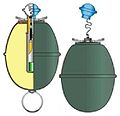Egg grenade 39
| Egg grenade 39 | |
|---|---|
| General Information | |
| Designation: | Egg grenade 39 |
| Type: | Hand grenade |
| Country of origin: | German Empire |
| Development: | 1939 |
| Commissioning: | 1940 |
| Working time: | 1940-1945 |
| Technical specifications | |
| Combat weight: | 230 g |
| Charge: | 112 g Donarit |
| Length: | 76 mm |
| Diameter: | 60 mm |
| Lists on the subject | |
The egg grenade 39 , also known as the egg grenade M39 or simply grenade 39 , was the most popular hand grenade of the Wehrmacht in the Second World War before stick grenades 24 and 43 .
description
It was about the size of an orange, 76 millimeters high, had a diameter of 60 millimeters, weighed about 230 grams and was made of thin steel. 112 grams of Donarit were used as explosives . It was constructed in 1939; Issued to the Wehrmacht in 1940 and built continuously until 1945.
This grenade was designed for attack situations. It was easy to store and easy to transport due to its compact size. However, there were some disadvantages compared to the stick grenade that was already in use. The load of 112 grams of Donarit was relatively weak compared to the stick grenade with almost 170 grams of TNT. It was accepted that several egg grenades were often needed to inflict serious damage on the enemy. For defense purposes a fragmentation jacket was also made for the egg grenade; In addition, their detonators could be mounted on the grenade heads of the stick hand grenade that were separated from the handle, the detonators of which were otherwise located in the wooden handle.
functionality
At the top of the egg grenade was a bluish colored button, which could be unscrewed and exposed a cord underneath. Pulling this activated the detonator and after a delay of four to five seconds the grenade exploded. The ignition mechanism was identical to that of the stick hand grenade.
Booby trap variants
For use as a booby trap , the detonator (blue button) was unscrewed and replaced by a detonator, which only had a delay of one second. This ignition device was marked with a red button. These prepared hand grenades were simply left in place during a retreat , where Allied soldiers, who were not familiar with the color code, were often surprised when they tried to use the grenade as a prey weapon .
Another modification of this grenade was made on the Eastern Front . Here the grenade was first dismantled into its individual parts, then the safety mechanism, i.e. the delay, was removed and the grenade was then reassembled. These grenades were also left at abandoned bases . If they were picked up by a Russian soldier and the blue button was removed and then the cord pulled, the grenade exploded instantly, and this almost always led to the soldier's death .
See also
literature
- Terry Gander, Peter Chamberlain: Encyclopedia of German Weapons 1939-1945 . 2nd Edition. Special edition. Motorbuchverlag, Stuttgart 2006, ISBN 3-613-02481-0 .
- D. Mitev, Bulgarian and German hand grenades - history, development, contemporary state, Vol. 1, 216 pages, ISBN 978-954-629-012-0 , Sofia, 2008

